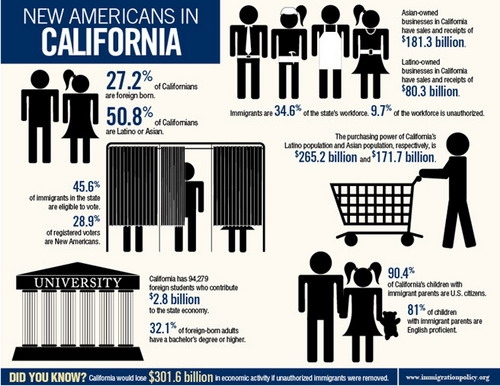Jan 23, 2012

Immigrants and their adult children account for roughly 1 in 4 of the state’s registered voters. Latino and Asian entrepreneurs (both foreign-born and native-born) own more than one-quarter of all businesses in the state, while Latino and Asian consumers account for nearly one-third of the state’s total purchasing power. Latino immigrants in California experience pronounced upward mobility over time in terms of mastering English and owning their own homes. And most native-born Californians have experienced wage gains from the presence of immigrants in the state’s labor market. These hardworking Californians have formed the backbone of the California economy throughout the state’s history, and they will be a key ingredient to California’s economic rebound.
Some key facts:
- More than one quarter of Californians are immigrants.
- More than half of Californians are Latino or Asian.
- In California, 90.4 percent of children with immigrant parents were U.S. citizens in 2009, and 93.3 percent of children in Latino families were U.S. citizens.
- Immigrants comprise more than one third of the California labor force (34.6 percent of the state’s workforce in 2010. They figure prominently in key economic sectors such as agriculture, manufacturing and services. Immigrants provide leadership and labor for the expansion of California’s growing economic sectors—from telecommunications and information technology to health services and housing construction.
- Immigrants in California pay roughly $30 billion in federal taxes, $5.2 billion in state income taxes, and $4.6 billion in sales taxes each year. In California, “the average immigrant-headed household contributes a net $2,679 annually to Social Security, which is $539 more than the average US-born household.
- Unauthorized immigrants comprised 9.7 percent of the California’s workforce in 2010 (or 1.9 million workers). Unauthorized immigrants in California paid $2.7 billion in state and local taxes in 2010. If all unauthorized immigrants were removed from California, the state would lose $301.6 billion in economic activity, decrease total employment by 17.4 percent, and eliminate 3.6 million jobs, according to a study by Dr. Raul Hinojosa-Ojeda and Marshall Fitz.
- Immigrant, Latino, and Asian entrepreneurs and consumers add hundreds of billions of dollars and more than a million jobs to California’s economy.
- The 2010 purchasing power of California’s Latinos totaled $265.2 billion—an increase of 287 percent since 1990.
- California’s 566,573 Latino-owned businesses had sales and receipts of $80.3 billion and employed 458,922 people in 2007. Together, businesses owned by Latinos and Asians comprised more than one-quarter of all businesses in the state.

- Most native-born Californians have experienced wage gains from immigration. “During 1990–2004, immigration induced a 4 percent real wage increase for the average native worker,” according to a 2007 study by economist Giovanni Peri of the University of California, Davis.30
- California’s immigrants move up the socioeconomic ladder over time—learning English, buying homes, and escaping poverty.
- A study by demographer Dowell Myers of the University of Southern California found that the share of California’s foreign-born Latinos who reported being proficient in English as of 2000 rose from 33.4 percent of those who had been in the United States for less than 10 years to 73.5 percent among those who had been here for 30 years or longer.
- Immigrants are integral to California’s economy as students. Naturalized citizens excel educationally. The number of immigrants in California with a college degree increased by 42.8 percent between 2000 and 2009.
- In California, 81 percent of children with immigrant parents were considered “English proficient” as of 2009.
- The English proficiency rate among Latino children it was 83 percent, as of 2009.
Source: Immigration Policy Institute, New Americans in California: The Political and Economic Power of Immigrants, Latinos, and Asians in the Golden State, January 2012.
Topics: